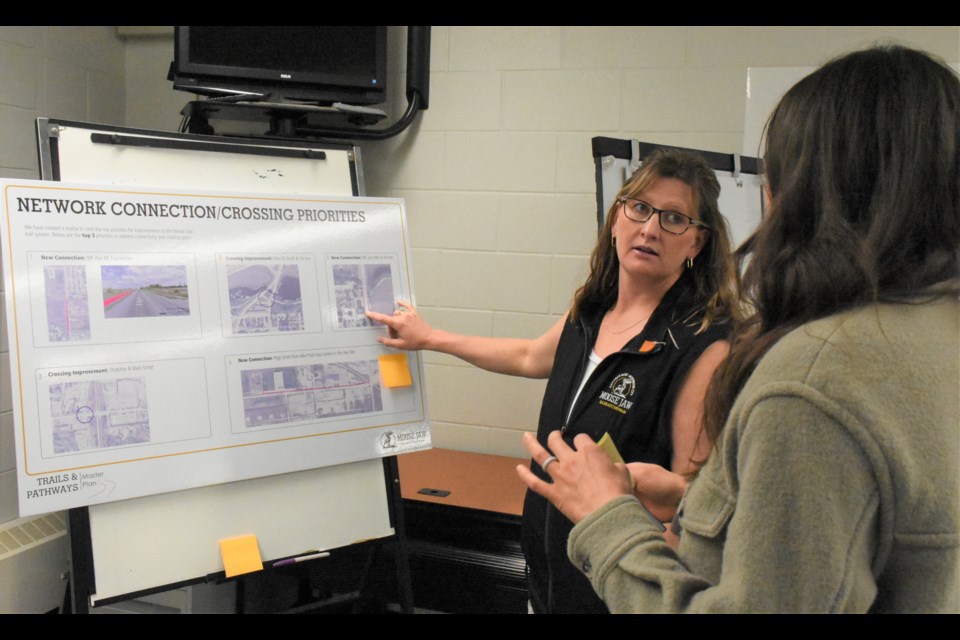There are over 40 kilometres of partially connected trails and pathways throughout Moose Jaw, but a new master plan aims to attach them together while upgrading old ones and installing new ones.
The City of Moose Jaw held an open house at the Kinsmen Sportsplex on May 11 during its second round of public engagement on the proposed trails and pathways master plan. Consulting firm Lees+Associates was present to answer residents’ questions about the plan and related map.
Resident Genelle Payant attended because she uses the paths daily to walk her daughter to school, while she is concerned about the trails’ condition in the Sunningdale area because of flooding and disrepair.
“I really wanted to come tonight to see what the plans were and have my concerns heard — and I have,” she said. “And it sounds like some of this stuff will be addressed with this plan, so that makes me really excited.”
A paved pathway/trail system that connects the entire city intrigued Payant since she thought it was smart and not something she had previously thought was an issue.
“I think that’s a really nice improvement and enhancement for our city,” she added.
Patrick Beech, a landscape designer with Lees+Associates, explained the firm took input from the first round of public consultations and created a draft plan, recommendations and principles.
It also identified gaps in the current trail/pathway system, such as places where the materials were inconsistent or in poor condition and areas where amenities are poorly connected, such as the Sportsplex to the nearby trail
“We’ve heard that residents really value the trails, but they want the system to be better connected,” he said. “There are currently spots where the trail ends (and) they have to use the road before getting back on the trail.”
Beech added that Lees+Associates will incorporate any further public feedback before finalizing the plan and presenting it to city hall, which will give the report to city council in June.
The first round of public consultations featured a stakeholder survey with nine responses, a public survey with 472 responses, three stakeholder workshops and two city staff workshops.
Those results showed 89 per cent of people used the trails daily or weekly, 25 per cent used the trails to reach work and 49 per cent used the trails regularly in the winter.
Furthermore, the top three areas for improvement included upgrading existing trails, adding new trail connections and enhancing ongoing maintenance. Meanwhile, the top three barriers included poor weather/winter weather (54 per cent), trail maintenance issues (45 per cent) and safety concerns (28 per cent).
Using this data, Lees+Associates created 16 principles and recommendations, including:
- Addressing gaps in the trail/pathway network
- Providing better connections for cyclists
- Creating one long continuous asphalt loop
- Improving crossings
- Installing curb ramps on sidewalks
- Establishing and applying a trail classification system and standards
- Optimizing priority routes for snow clearing
- Collaborating with city departments to create a cohesive transportation network
- Providing trail amenities consistently around the network
- Installing labelled distances to facilitate training and races
- Providing more opportunities for winter activities where possible
- Updating print and web-based trail maps and information
- Adding interpretive signs in main locations that celebrate heritage, ecology and environment
- Creating a consistent trail wayfinding sign strategy
- Establishing a trail code of conduct with etiquette and safety info
- Establishing a monitoring/reporting process for the system
Derek Blais, director of parks and recreation, believes the master plan will help the department prioritize upgrades while addressing safety.
“It’s an important project that’s really going to help with our long-term planning,” he said, adding the response to the initial survey was one of the highest ever for a city questionnaire, which he thought showed how passionate residents are about this issue.
Visit moosejaw.ca for more information.




